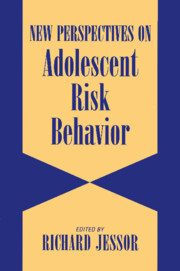Book contents
- Frontmatter
- Contents
- List of contributors
- Preface
- 1 New perspectives on adolescent risk behavior
- Part I A focus on development
- Part II A focus on problem behavior
- Part III A focus on sexual activity
- Part IV A focus on psychopathology
- 10 New perspectives on depression during adolescence
- Part V A focus on social role performance
- Part VI Overview and integration
- Author index
- Subject index
10 - New perspectives on depression during adolescence
Published online by Cambridge University Press: 06 July 2010
- Frontmatter
- Contents
- List of contributors
- Preface
- 1 New perspectives on adolescent risk behavior
- Part I A focus on development
- Part II A focus on problem behavior
- Part III A focus on sexual activity
- Part IV A focus on psychopathology
- 10 New perspectives on depression during adolescence
- Part V A focus on social role performance
- Part VI Overview and integration
- Author index
- Subject index
Summary
Perhaps more than any for other form of psychopathology, the past several decades have witnessed enormous changes in the recognition of depression as a problem of adolescence. Perspectives have changed from an initial view that depression could not occur in children and adolescents to the acknowledgment of depression as a major mental health concern among young people. We are now witnessing a third phase in the changing perspectives on depression in adolescence. The new perspectives that are emerging are important not only for understanding this disorder but, more broadly, for understanding other forms of psychopathology during adolescence.
The earliest perspective on depression during adolescence was that depression could not occur during this period of development or, if it did occur, it would be masked by other problems or disorders (Poznanski & Mokros, 1994). This belief was based on the theoretical position, derived from psychoanalytic theory, that depression was impossible in children or adolescents because of inadequate development of the superego. If depression could occur, it was assumed that it would be overshadowed by other characteristics or problem behaviors. For example, depression was often assumed to be masked by disruptive behavior disorders. Both of these issues have now been thoroughly dispelled by research verifying that children and adolescents do indeed experience and present clinically with depression (Carlson & Cantwell, 1980; Hammen & Compas, 1994).
During the 1970s and 1980s, these early views gave way to the recognition that young people do indeed suffer from symptoms of depression in a manner similar to that of adults.
- Type
- Chapter
- Information
- New Perspectives on Adolescent Risk Behavior , pp. 318 - 361Publisher: Cambridge University PressPrint publication year: 1998
- 8
- Cited by

